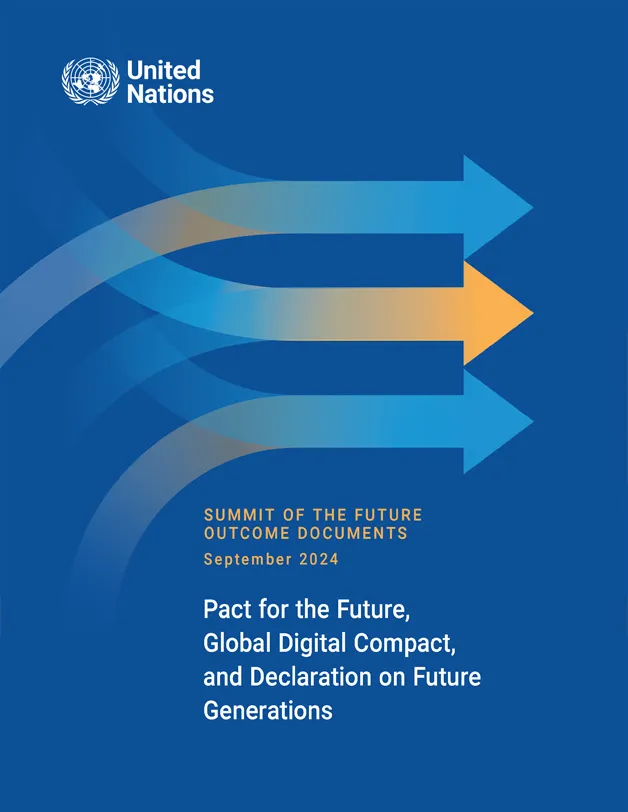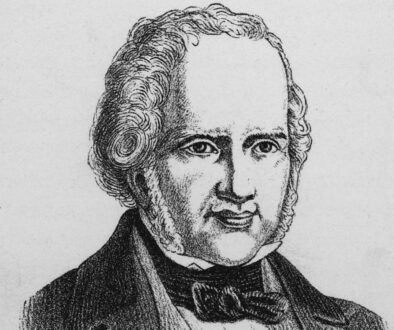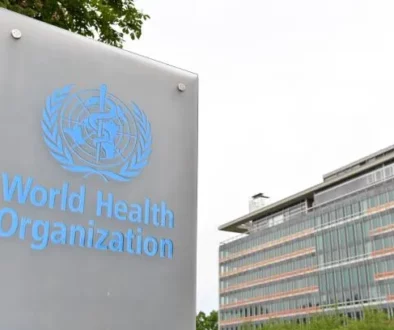Pact for the future
At the Summit of the Future on 22 September 2024, world leaders {193 countries} adopted a Pact for the Future that includes a Global Digital Compact and a Declaration on Future Generations. This Pact is the culmination of a years-long process to adapt international cooperation to the realities of today and the challenges of tomorrow. The hard work of implementation begins immediately.
The adoption of the Pact demonstrates that countries are committed to an international system with the United Nations at its center. Leaders set out a clear vision of a multilateralism that can deliver on its promises, is more representative of today’s world and draws on the engagement and expertise of governments, civil society and other key partners.
The Pact is the most wide-ranging international [United Nations] agreement in many years, covering both new areas and issues on which agreement has not been possible in decades. Above all, it aims to ensure that that international institutions can deliver in the face of a world that has changed dramatically since they were created. It makes clear commitments and achieves concrete deliverables on a range of issues, with strong attention to human rights, gender and sustainable development.
Sustainable Development and Financing
Member States recommitted to accelerate the implementation of the 2030 Agenda and of the 2023 SDG Summit Political Declaration through urgent and scaled-up action, policies and investments with the goal to end poverty and hunger and leave no one behind. The Pact also acknowledges the need for Member States to begin to consider how to advance sustainable development beyond 2030.
Global leaders agreed on a step-change in financing for the SDGs and closing the SDG financing gap, including through an SDG Stimulus, reaching official development assistance targets, private sector investment, mobilization of domestic resources, inclusive and effective international tax cooperation, and consideration of a global minimum level of taxation on high-net-worth individuals.
On climate change, the Pact confirmed the need to keep global temperature rise to 1.5°C above pre-industrial levels, to transition away from fossil fuels in energy systems to achieve net-zero emissions in 2050 and promote disaster risk-informed approaches to sustainable development.
It also calls for accelerated efforts on the environment, including the promotion of sustainable consumption and production patterns, the conclusion of a legally-binding agreement on plastic pollution, reversing biodiversity loss and protecting ecosystems.
INTERNATIONAL PEACE AND SECURITY
Global leaders vowed to intensify diplomacy to settle conflicts and disputes peacefully, supported by the UN and the UN Secretary-General’s good offices.
The Pact promotes the need for national whole-of-society sustaining peace efforts through the development and implementation of voluntary national prevention strategies. Strengthened resilience through implementation of the 2030 Agenda, and the importance of ensuring that military spending does not compromise sustainable development investments. Stronger alignment of international financial institutions’ funding with countries’ efforts to address root causes of instability.
The Pact commits to protecting civilians in armed conflict by complying with the laws of war. It also includes a pledge to refrain from the use of explosive weapons in populated areas, and to strengthen accountability for serious crimes and gross violations, such as gender-based violence and starvation as a weapon of war. It agrees to scale-up humanitarian assistance and increase the use of innovative and anticipatory financing mechanisms, including to eliminate famine.
Leaders also agreed to accelerate the implementation of commitments on Women and Peace and Security and Youth, Peace and Security.
The Pact asks for a review of United Nations peace operations to recommend how they can adapt to new and emerging challenges and promotes counter-terrorism efforts that address all drivers and enablers of terrorism and violent extremism conducive to terrorism, including in the digital sphere. It also affirms the need to prevent and combat transnational organized crime, including cybercrime.
One of the Pact’s most significant achievements is the first recommitment to nuclear disarmament in nearly 15 years, through a clear commitment to the goal of the total elimination of nuclear weapons, as well as concrete steps on all aspects of disarmament.
The Pact also advanced steps to avoid the weaponization of emerging domains and technologies through:
- a commitment to prevent an arms race in outer space;
- discussions on an instrument to govern the use and development lethal autonomous weapon systems; • continued assessment of risks around the military applications of AI.

SCIENCE, TECHNOLOGY AND INNOVATION (STI) AND DIGITAL COOPERATION
The Pact introduces measures to reduce global disparities in science, technology and innovation, including through scaling-up means of implementation. It addresses barriers to the access, participation and leadership of women and girls in these areas and agrees on the importance of human rights and ethical principles in the development and use of new technologies.
Leaders also committed to the increased use of science in policy-making to address complex challenges, and to more funding for SDG-related research and innovation. They decided to strengthen capacities at the UN to leverage STI in the work of the organization, including to support developing countries in achieving the SDGs.
YOUTH
The Pact aims to expand and strengthen youth participation in global decision-making, including in UN intergovernmental bodies and processes. It agrees to the participation of youth from developing countries, facilitated through the UN Youth Fund and development of core principles for meaningful youth engagement.
It will strengthen youth participation at the national level, including through the establishment of consultation mechanisms and creating environments that enable young people to fulfill their rights and potential through education, jobs, physical and mental health, resources for youth-led organizations, and flexible funding, including through a global youth investment platform.
TRANSFORMING GLOBAL GOVERNANCE
The Pact resolved to make the multilateral system more effective, fit for the future, just and representative, inclusive and networked, and financially stable.
It includes the most ambitious and concrete progress on Security Council reform since 1963, including a commitment to increase the representation of developing countries, recognizing the special case of Africa, and to develop a consolidated reform model in the future.
Recommitting to the achievement of gender equality and the empowerment of all women and girls, leaders agreed to take steps towards the revitalization of the Commission on the Status of Women. They also underscored their aspiration for a female Secretary-General.
On human rights the Pact is clear on the need to ensure the enjoyment by all of all human rights, including through UN human rights mechanisms that are effective and have adequate means to respond to a range of human rights challenges. It also makes a clear appeal to protect human rights defenders.
To address current, new and emerging challenges to sustainable development, the Pact calls for increased adequate, predictable and sustainable funding for the UN Resident Coordinator System.
The Pact also agreed steps to deepen partnerships between the UN and other stakeholders, including civil society, the private sector, regional organizations, national parliaments and local and regional authorities. It calls for a UN that uses innovation, data, digital tools, foresight and (behavioural) science effectively.
The Pact presents the most detailed agreement ever at the United Nations on the need to reform the international financial architecture, so that it works for everyone and reflects the economic needs and realities of today, achieved through inter alia:
- stronger participation of developing countries in international economic decision-making, including through enhanced representation at international financial institutions;
- the mobilization of more financing from multilateral development banks to help developing countries turbocharge their development needs;
- a review of the sovereign debt architecture to ensure that developing countries can borrow sustainably to invest in their future, conducted jointly by the IMF, the UN, the G20 and other key players;
- a strengthened global financial safety net to support countries in the event of financial and economic shocks, using special drawing rights;
- delivering more finance to help countries address climate change and invest in adaptation and renewable energy. Leaders decided on concrete next steps to develop measures of progress on sustainable development beyond GDP, capturing human and planetary wellbeing and sustainability.
On governing outer space, the Pact includes an agreement to strengthen the existing international frameworks including to ensure that all countries can benefit from its safe and sustainable exploration and use, and working with non-State actors where relevant.
The Pact also calls for an improved international response to complex global shocks and proposes the consideration of approaches to strengthen the UN system’s response, within existing authorities and in consultation with Member States.
GLOBAL DIGITAL COMPACT
Annexed to the Pact, the Global Digital Compact is the first comprehensive global framework for digital cooperation. It explicitly includes human rights and concrete commitments to accelerate progress on the 2030 Agenda and puts emphasis on the role of non-state stakeholders. It makes the first global commitment to digital public goods and digital public infrastructure; to open-source data, models and standards; and to data governance. In the Compact, leaders also agreed on ambitious steps to make the digital space safer for all through greater accountability of tech companies and social media platforms and actions to tackle disinformation and online harms.
The Compact includes an agreement on a roadmap for global AI governance, through the establishment of an AI Scientific Panel, global policy dialogue on AI and exploration of the establishment of a Global Fund for AI capacity building.
DECLARATION ON FUTURE GENERATIONS
Leaders agreed the first ever Declaration on Future Generations, recognizing our obligations and putting in place steps to systematically take future impact into account, consciously avoiding foreseeable harms to and safeguarding the interests of future generations.
The Declaration puts forward concrete proposals and processes to help Member States better consider future generations and inspire long-term anticipatory governance at the international level.
SUMMIT FOLLOW-UP
The Pact and its annexes foresee concrete follow-up mechanisms: a high-level review for the Global Digital Compact in 2027, a high-level plenary meeting in 2028 for the Declaration on Future Generations, and a Heads of State and Government meeting at the beginning of the 83rd session of the General Assembly in 2028 for a comprehensive review of the Pact for the Future.
The Fourth International Conference on Financing for Development, the Second World Summit for Social Development and the upcoming UN Climate Change Conferences, among other global events taking place in the next few years, are opportunities to build on the agreements and advance the actions contained in the Pact for the Future.
Last but not least, national-level engagement, implementation and accountability will be essential to put the agreements into action.



